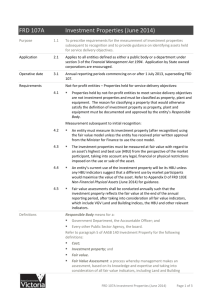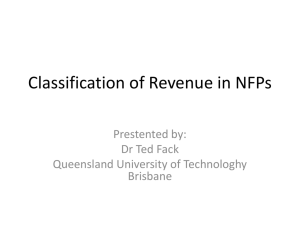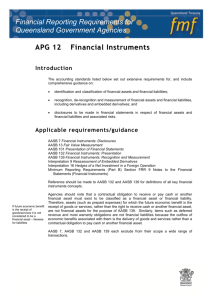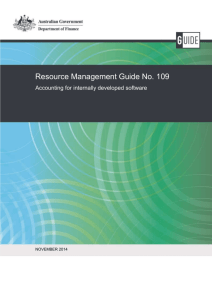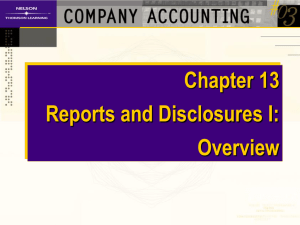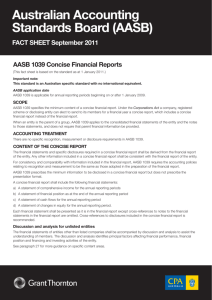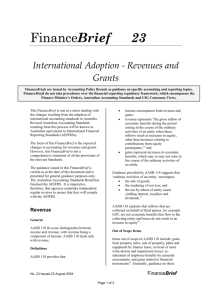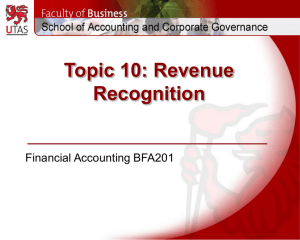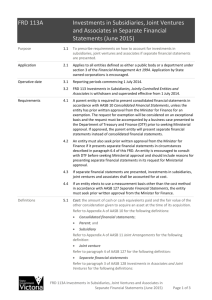C1: AASB13: Fair value measurement
advertisement
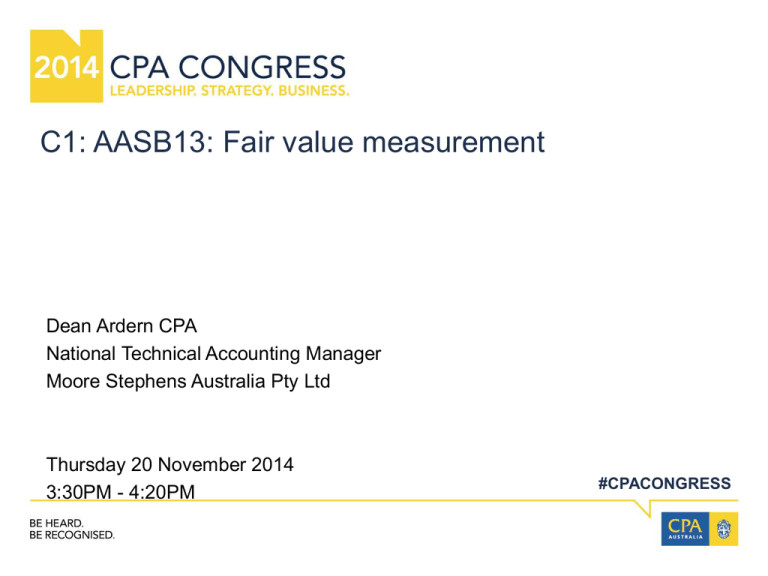
C1: AASB13: Fair value measurement Dean Ardern CPA National Technical Accounting Manager Moore Stephens Australia Pty Ltd Thursday 20 November 2014 3:30PM - 4:20PM #CPACONGRESS AASB 13: Fair Value Measurement Will cover… • AASB 13 refresher • Common application issues for non-financial entities • Classification in hierarchy • Implications for NFP entities Won’t cover… • Applying measurement models, incl. portfolio basis for financial instruments • Entity’s own equity instruments • Pricing in bid-ask spread • Dealing with significant decrease in the volume/level of activity in a market Components of AASB 13 The price that would be received to sell an asset or paid to transfer a liability in an orderly transaction between market participants at the measurement date. (AASB 13, Appendix A) Unit of Account Principal (most advantageous) market Market participants Transaction Price When does AASB 13 apply? General principle •When another AAS requires FV measurement or disclosure (incl. FV less costs to sell) •When another AAS permits FV measurement and the entity adopts the policy •When an entity voluntarily discloses FV in respect of an item not measured at FV in its statement of financial position Scope exclusions (measurement and disclosure) •Equity-settled share-based payments (AASB 2) •Finance leases (AASB 117) [except for initial measurement of finance leases acquired in business combinations (AASB 3)] •Measurements similar to but not FV [eg, net realisable value (AASB 102) and value in use (AASB 136)] Disclosure exceptions •Defined benefit plan assets (AASB 119) •Assets for which recoverable amount is fair value less costs of disposal (AASB 136) •Assets and liabilities not measured or disclosed on a ‘recurring’ basis or ‘nonrecurring’ basis Accounting Standard Item Recognised or Disclosed? Required or Permitted? Recognised Permitted Recognised and disclosed Required Recognised Required AASB 1: First-time Adoption of Australian Accounting Standards Various , including PPE, subsidiaries, JVs, associates AASB 3: Business Combinations • • AASB 5: Non-current Assets Held for Sale and Discontinued Operations Non-current assets and disposal groups held for sale AASB 12: Disclosure of Interests in Other Entities Interest in listed JV or associate Disclosed Required AASB 116: Property, Plant and Equipment Property, plant and equipment Recognised Permitted AASB 128: Investments in Associations and Joint Ventures Investment in associate or JV held by venture capital organisation Recognised Permitted AASB 138: Intangible Assets Intangible assets for which there is an active market Recognised Permitted AASB 139: Financial Instruments: Recognition and Measurement • • Acquisition consideration Most assets and liabilities acquired Financial instruments at fair value through profit or loss Financial instruments at amortised cost • • Recognised Disclosed when specified criteria met • Required for some instruments, permitted for others • Required when specific criteria met AASB 140: Investment Property Investment property Recognised Permitted AASB 141: Agriculture Biological assets and agricultural products Recognised Required AASB 1004: Contributions Assets received by NFPs as contributions Recognised Required Unit of account Defines what is being measured – level of aggregation (disaggregation) FV unit of account – generally determined by Standard that requires/ permits fair value, except that AASB 13: • • requires FV = price x quantity for single asset traded in active market (ie, ignore ‘blockage’ factors) permits ‘net’ positions for specific entities that manage groups of financial assets/ liabilities with offsetting market or credit risks Restrictions on sale/use – characteristic of entity or asset? Interaction between unit of account and valuation premise (market participants) concepts Unit of account issues Shares in listed company pledged as collateral in 3rd party borrowing Shares in unlisted company that can only be sold to specified parties or at specified period Lease incentives Not-for-profit-specific issues • • property vs. right to use property donor restrictions over use of property Principal (most advantageous) market From entity’s perspective, but: • • question of fact not determined by managements’ intentions Principal market – market with greatest volume and level of activity for asset/liability • market entity would normally utilise for specific asset/liability When principal market for asset/liability exists, FV is market price at measurement date When no principal market exists, then most advantageous market - market that maximises/minimises amount received/paid to sell/transfer asset/liability (incl. transaction and transport costs) • • entity must have access, but no need to be able to transact on measurement date only transport costs included in FV (transaction costs excluded) If both types of markets exist, must use principal market In many cases principal market = most advantageous market Principal (most advantageous) market issues Same goods/services sold in two different markets at different prices and principal market is not the market in which net proceeds are maximised Same goods/services sold in multiple markets and availability of volume/activity of some or all markets not readily available Market participants Provide basis for FV assumptions - market-focused, not entity specific Identify based on principal or, if applicable, most advantageous market Need not identify specific market participants • • characteristics of market participants that would generally transact for items (incl. entity’s competitors) ignore advantages (eg, synergies) that particular market participants might have Market participants have all of the following characteristics: • • • • • independent (not related) knowledgeable and sufficiently informed on asset/liability able to enter into a transaction willing to enter into a transaction act in their own economic interest Highest and best use Only applicable to non-financial assets Current use presumed highest and best, but need to consider all uses (including strategic non-use) If alternative use is highest and best, must generate sufficient return for market participants For not-for-profits, alternative use generally higher and better use (from market perspective) Characteristics of the asset, including: • age and remaining economic life • condition • location • restrictions on use/sale • contractual terms Alternative uses: • physically possible • legally permissible • financially feasible Valuation premise (unit of valuation) – maximise value: • in combination with other assets/ liabilities • on stand-alone basis Market participant/highest and best use issues Identifying all potential alternative uses/market participants Potential for re-zoning property Holding assets for strategic/defensive (non-operating) purposes Transaction With respect to the item subject to FV measurement, it is a hypothetical transaction. Therefore, ignore: • • whether management actually intends to transact entity has the ability to enter into transaction Transaction assumed to: • • • • • occur in principal (or most advantageous) market occur on measurement date be orderly (not forced or liquidation related) involve market participants (see previous slide) take place under measurement date conditions Price Conceptually, exit (rather than entry) price Initial transaction (entry) price could represent FV provided that: • • • • both transactions occur in the same market both transactions are for similar or the same units of account both transactions are not between related parties seller is not distressed or forced • Exclude transaction costs • Include transportation costs if location is relevant characteristic • Priority given to quoted market price in active market for identical item, otherwise maximise use of observable inputs • For non-financial assets, highest and best use establishes valuation premise, which in turn determines FV of asset Transaction/price issues Transaction/price matches unit of account Extent of adjustments to prices arising from related party transactions Agreement to sell property subsequent to year end at discount to FV Implications of using entity-specific inputs for recoverable amounts Fair value of liabilities FV measurement of liability contemplates transfer (not settlement or extinguishment) to market participant on measurement date: • • assume liability remains outstanding and market participant transferee fulfil obligation reflects effect of ‘non-performance risk’ Non-performance risk – credit standing or likelihood that obligation will not be fulfilled • • • • includes, but not limited to, entity’s own credit risk considered from perspective of liability, not entity assumed same before and after transfer of liability adjusted in all periods liability is FV measured Fair value of liabilities Quoted transfer prices generally unavailable for liabilities If identical item held by another entity as asset available, measure FV of liability from perspective of market participant holding asset When quoted price not available, and identical item not held by another party as asset, FV liability using valuation technique from perspective of market participant owing liability using: 1. a present value technique, taking account of: o o 2. market participants’ expectations about the costs of fulfilling obligation compensation that market participant would require for taking on obligation, including return required for: undertaking the activity (opportunity cost) risk premium amount market participant would receive to issue an identical liability, using assumptions market participants would use when pricing the identical item in principal (most advantageous) market Per AASB 139, FV of financial liability with demand feature not less than amount payable on demand, discounted from first date amount required to be paid Fair value hierarchy Quoted price in active market? yes no Adjusted? Level 1 no Replicate quoted price in active market using another valuation technique Any significant unobservable inputs? yes no yes Level 2 Level 3 Examples of Level 2 and Level 3 inputs Level 2 • transaction prices in markets that that are not active for identical items • quoted prices in active markets for similar items • transaction prices in markets that are not active for similar items • interest rates derived from quoted bond prices • quoted foreign exchange and interest rates (forward currency and swap rates) • implied volatilities derived from quoted option prices • credit spreads derived from quoted credit default swap prices Level 3 • interest rates in a currency that are not observable and cannot be confirmed by observable market data for the term of the item • volatility for a share option derived from historical share prices • credit risk based on historical data on credit losses • observable inputs used as proxies for unobservable inputs Fair value hierarchy input examples Prices derived from a third-party pricing service or brokers Units in an unlisted investment fund are regularly bought and sold but only between the fund manager and related parties Closing price of a share on a national stock exchange that is impacted by a public announcement subsequent to the close of the market but still on the measurement date Subscription to shares through initial public offering Item of PPE that is measured using CPI as a proxy for a more specific price index NFP-specific fair value issues Highest and best use • • • Current/depreciated replacement cost • • • legally permissible (statutory protections) public sector-specific assets price adjustment for restrictions over use that transfer with asset fair value hierarchy level use of indexes disclosures re unobservable inputs Interaction between quality of asset register, hierarchy categorisation and level of disclosures AASB project on NFP public sector implementation issues NFP constituent (local government) feedback primarily relating to Level 3 measurements of non-financial assets Constituent concerns included: • • • • grouping assets into broader classes is difficult (different nature and risks), which increases extent of FV disclosures cost and complexity of disclosures, particularly sensitivity analyses and disclosures about interrelationships between inputs arguably not beneficial to users (complexity and length of disclosures) consistency of categorisation of inputs across entities AASB decided at September 2014 meeting to undertake project to review whether disclosures under AASB 13 be modified for NFP public sector entities
